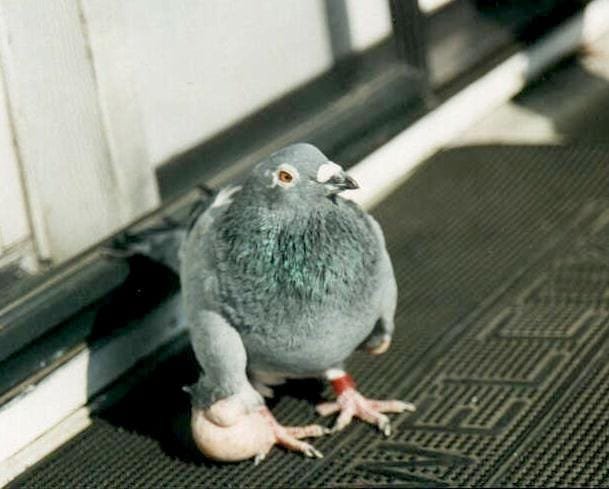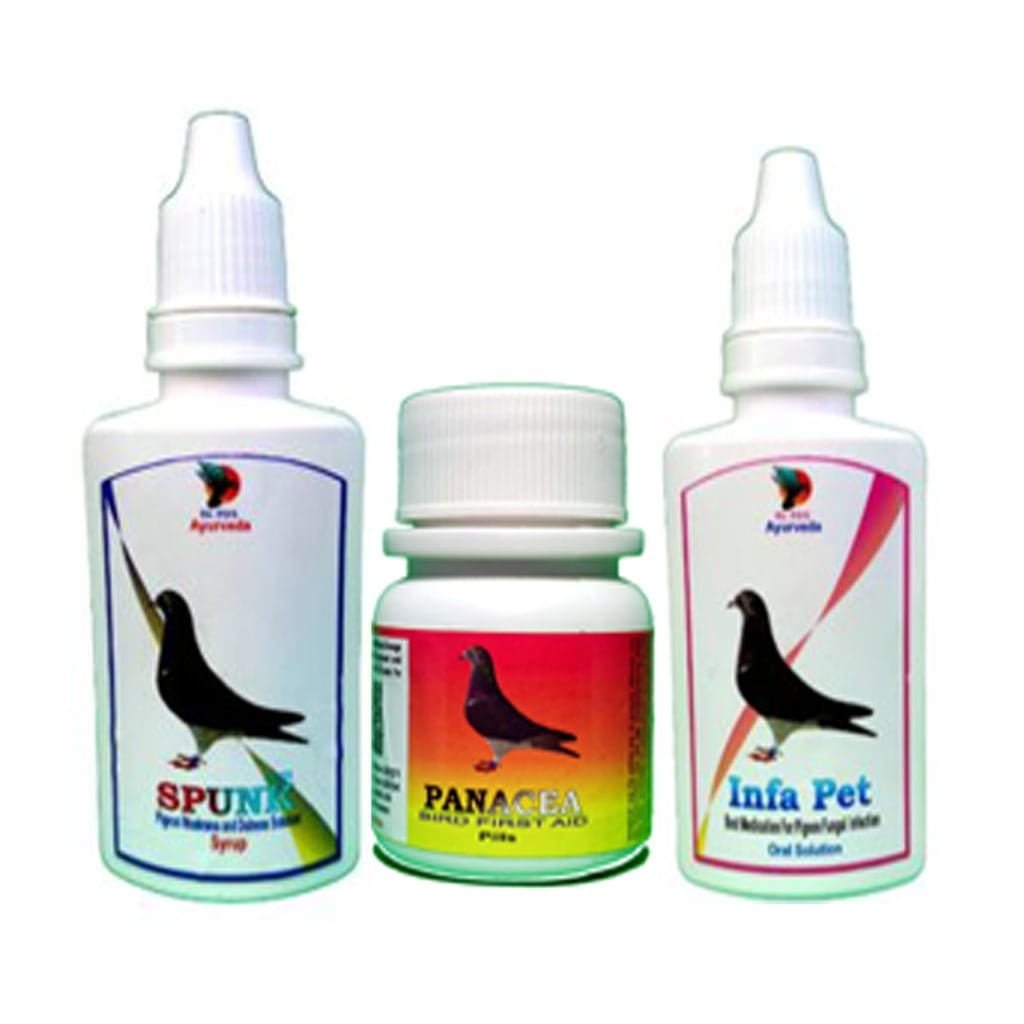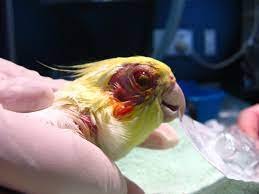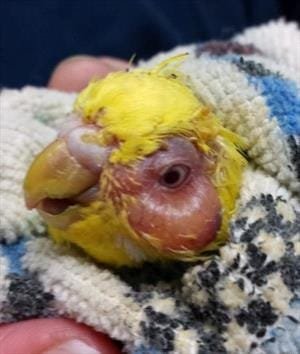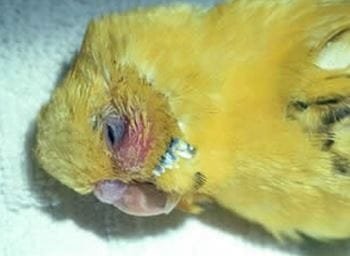Do your Rooster and Hens have Canker Disease? “
is a term we often get from customers, and many times, hear their desperation in their voice when they have a serious case in their flock. Canker in birds is a deceiving and persistent condition that should not be taken lightly, however, with proper observation, preparation, and preventative measures, you can learn to live with it while minimising the number of cases.
What is Canker, Anyway?
Canker, scientifically known as Trichomonas columbae, is a microscopic protozoan parasite that affects the bird’s digestive tract, which includes the crop, throat, and other internal areas. Infection often leads to inflammation and ulceration in the upper digestive tract, which is usually in the form of the commonly seen yellow, cheesy-like lesions in the mouth and throat. Pictured above: a microscopic look at the canker organism, known as a trichononad. Their fast motility, which is done by their tail (Axial rod), allows them to quickly move and cross-contaminate. Contrary to what some fanciers and enthusiasts believe, canker is not a bacteria or virus, so treating it with an antibiotic or anti-viral suppressant will not eradicate the trichomonads – it’ll only help with secondary infections (if they are bacterial and/or viral).
Identifying Canker and its Common Symptoms
Canker can be easily mistaken for other types of ailments that produce similar in-mouth sore which include: Mycotoxicosis (ingestion of toxic grains) Capillary Worms Calvary Stones Sour Crop (fungal) *Wet Pox (viral) Since many conditions may look like canker, the only way to get a definite diagnosis is to consult with a veterinarian or by examining a sample under a microscope.
SOME COMMON PHYSICAL SYMPTOMS OF A BIRD INFECTED WITH CANKER INCLUDE:
High mortality, especially in young birds/chicks Accumulated mucus in the throat Difficulty Swallowing Vomiting Yellow or whitish cheesy/crusty growths in their mouth and throat Weight loss Difficulty breathing *Puffed feathers *High mortality, especially in young birds/chicks
How is Canker Transmitted and which Birds are more Susceptible?
Canker organisms rely on the intimate relationship between it and the host so it does not survive in an outside environment for too long. It thrives on transmitting itself in saliva and crop milk so it primarily spreads via contaminated water, food, and through the parents’ feeding the young. This, along with upward to 80% Rooster and Hen already being natural carriers of canker, makes it extremely difficult to prevent and control the transmission. Pigeons are the most susceptible but it’s also a very common illness in chickens and cage birds – both showing similar symptoms. As you could imagine, young birds in the nest, and chicks, have the weakest immune systems (and are fed crop milk) so fanciers and enthusiasts mainly experience canker in their flock within this age group. They also experience a higher mortality rate since they have not fully developed. Additionally, canker during the young and old bird race seasons (pigeons) is also very common since these birds are regularly exposed to the environment, open watering sources, and other wild birds. Free-range chickens also experience higher cases of canker since they are also exposed to the environment and other wild birds.
How to Treat and Prevent:
What is challenging about canker is that it can become immune to specific active ingredients, so alternating them throughout the year is advised. However, it cannot be fully controlled with only medication. A thorough preventative treatment on all stock birds prior to breeding should be administered. When breeding, all young birds and chicks should be checked daily. Additionally, young birds and chicks should be treated with Our Products (which has a wide safety margin) for 3-5 days after they’ve weaned from the parents. Canker flare-ups can also occur during periods of high stress such as racing, showing, transporting, and breeding. Preventative treatment (whether individual or flock) should be considered. Unfortunately, secondary infections are also common when a bird is infected with canker, and at times are the main reason for death. Common secondary infections include: Salmonella Coccidiosis E.coli Mycoplasma (respiratory)
Common canker active ingredients in medication are:
* COCKEREL Canker Powder. Canroos
Warning: the above canker active ingredients should not be used on birds whose meat or products are intended for human consumption. Some canker treatments come in a Powder form and only require you to treat for 3-5 days. This is the most effective way of treating sick birds since each one is insured their required daily dosage to properly eradicate it. Treatment Process:- Throat Cancer / Cancer, Oral Cancer / Stomach Cancer * In the morning and evening after water and grain, give Cancer Powder) Do not water from above. Give this medicine for 5-7 days. Caution: – Do not touch the wound.
Dosage:-
* For Cock 3 times more than black gram. उपचार प्रक्रिया:- गले का कैंसर/कंकर (सफेद रेशेदार गांठ), मुंह का कैंसर/कंकर।(सफेद रेशेदार गांठ), पोट में कैंसर/कंकर सुबह ओर शाम दाना-पानी खिलाने के बाद “कंकर पाउडर दें। उपर से पानी ना दें॥ यह दवा 5-7 दिन दें॥ सावधानी:- जखम के साथ कोई भी शेड-शाड न करें।
खुराक:-
* मुर्गे के लिए काले चने से 3 गुना ज्यादा दें। ਇਲਾਜ ਦੀ ਪ੍ਰਕਿਰਿਆ:- ਗਲ਼ੇ ਦਾ ਕੈਂਸਰ / ਕੰਕਰ (ਚਿੱਟਾ ਰੇਸ਼ੇ ਦੀ ਗੱਠ) , ਮੂੰਹ ਦਾ ਕੈਂਸਰ / ਕੰਕਰ (ਚਿੱਟਾ ਰੇਸ਼ੇ ਦੀ ਗੱਠ), ਪੋਟ ਦੀ ਕੰਕਰ (ਚਿੱਟਾ ਰੇਸ਼ੇ ਦੀ ਗੱਠ) ਇਲਾਜ ਦੀ ਵਿਧੀ:- ਸਵੇਰੇ ਅਤੇ ਸ਼ਾਮ ਨੂੰ ਦਾਣੇ ਪਾਣੀ ਤੋਂ ਬਾਅਦ, “ਕੰਕਰ ਪਾਉਡਰ ਦਿਓ। ਉੱਪਰੋਂ ਪਾਣੀ ਨਹੀਂ ਦੇਣਾ। ਇਸ ਦਵਾਈ ਨੂੰ 3-5 ਦਿਨ ਦਿਓ। ਸਾਵਧਾਨ:– ਜ਼ਖ਼ਮ ਨਾਲ ਕੋਈ ਪਵੀ ਛੇੜ ਛਾੜ ਨਾ ਕਰੋ।
ਖੁਰਾਕ:-
* ਕਾਲੇ ਚਨੇ ਨਾਲੋਂ 3 ਗੁਣਾ ਜ਼ਿਆਦਾ ਕੁੱਕੜ/ਕੁਕੜੀ ਨੂੰ ਦਿਓ।






